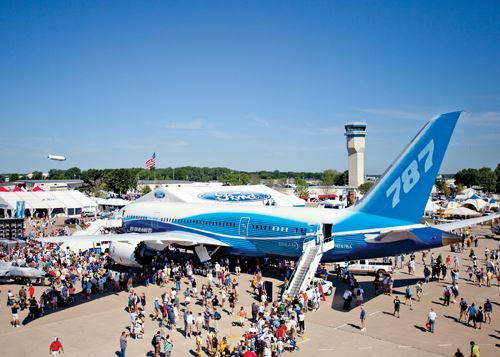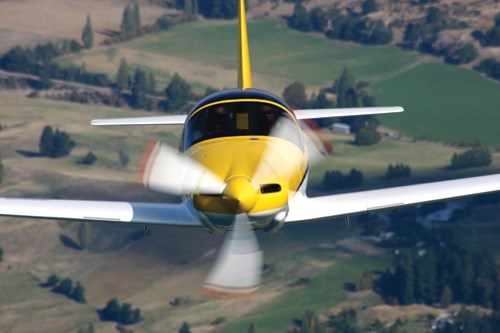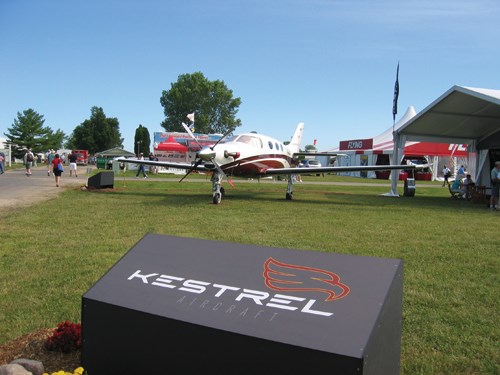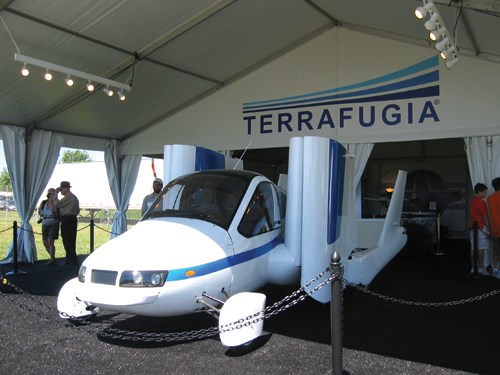EAA AirVenture 2011 air show
Plenty of “oh, my gosh” to go ’round in Oshkosh.
The 59th annual Experimental Aircraft Assn.’s (EAA) AirVenture fly-in convention was, as always, hot — in more ways than one. High on the list of hot attractions was the 787 Dreamliner. The fabled Oshkosh fly-in formed the backdrop for the first public showcase of The Boeing Co.’s (Chicago, Ill.) midsize passenger jet — its 50 percent composite airframe the result of one of the most ambitious experiments in aviation history. It touched down in Oshkosh on July 29 as this report was filed for publication, and its cabin doors were opened for public tours. Also on hand and offering aerial tours of the fly-in grounds and the surrounding area (a hot ticket, at $350 each) was Eureka, the largest flying airship in the world: Also known as the Farmers Airship, the aircraft is a zeppelin operated by Airship Ventures (Sunnyvale, Calif.). Zeppelins are propeller-driven and have a rigid internal framework of carbon-composite and aluminum frames and polymer cables. This distinguishes them from blimps, which maintain their shape due to internal pressure from contained lifting gas.
Large crowds braved the summer heat (EAA estimates a 4 percent increase in attendance over 2010), thronging the static aircraft displays (including more than 2,500 showplanes), forums, workshops and seminars, exhibits and viewing areas to watch the ever-changing aerial displays of vintage and modern planes. EAA reports that more than 10,000 aircraft were flown in for the event. HPC had the opportunity, once again, to walk the show and search out some new composite innovations and news.
Among the more than 800 exhibitors, the principal general-aircraft OEMs were out in force. Cessna (Wichita, Kan.), Hawker Beechcraft (Wichita, Kan.), Cirrus (Duluth, Minn.), Embraer (São José dos Campos, Brazil), Eclipse Aerospace (Albuquerque, N.M.) and more joined a wide array of smaller kit-plane producers and upstart specialty composite aircraft manufacturers. A standout was the large Kestrel Aircraft (Brunswick, Maine) display, the centerpiece of which was a current mock-up of its composite-airframed Kestrel turboprop. The new version has more cabin room than the original prototype, with multiple customer interior options (see “General aircraft ...." under "Editor's Picks" at top right). The company announced that it has selected a Honeywell Aerospace engine for the plane, and the company’s chairman and CEO, Alan Klapmeier, the cofounder of Cirrus, announced the formation of Kestrel Aeroworks, a division for aftermarket upgrades to Piper Meridian and Cirrus aircraft. According to the EAA, Klapmeier anticipates certification of the plane in three years.
New to HPC was Composite Aircraft Technology LLC (Toledo, Wash.), producer of the Express kit aircraft. Combining speed, utility, comfort and style, the Express, available in either fixed gear or retractable formats, is designed for the first-time kit builder, says the company. The fiberglass components also can be assembled by the company through its builder-assist program.
HPC had the opportunity to speak with Marco Túlio Pellegrini of Embraer, who is the senior VP of operations and COO of the company’s Executive Jets division. Pellegrini says that while composites have been limited promarily to empennage structures on Embraer models to date, including the Phenom 100 and 300 jets, trade studies involving composite materials are currently underway that signal greater use on future Embraer aircraft. He believes the business-jet market is “coming back,” and he is optimistic for 2012 and beyond. Watch for a more complete “Q&A” article highlighting Pellegrini’s remarks in the November 2011 issue of HPC.
In its sixth appearance at AirVenture, Terrafugia (Woburn, Mass.) exhibited its Transition “roadable aircraft.” This year, the Transition on display was built entirely from production tooling, say company officials, and it is the first of the company’s production prototypes. Though not 100 percent complete, the aircraft is “coming together well,” say company officials. After Oshkosh, the remaining systems will be completed and certification testing will begin. Built primarily from carbon/epoxy prepregs, the Transition vehicle recently received some key exemptions from the U.S. Department of Transportation (for special tires and a polycarbonate windscreen, among others) that the company says were needed for the vehicle’s successful launch. A second production prototype is under construction.
Burt Rutan gave some details during a home builders chat session about the new hybrid-powered, composite-airframed BIPOD flying car that he designed prior to retiring from Scaled Composites (Mojave, Calif.) last November (see more coverage of the BIPOD in "Aspiring roadworthy aircraft ...." under Editor's Picks"). As reported by EAA, Rutan says that unlike the Terrafugia Transition, which changes from car to plane with the touch of a button, the pilot will have to get out of the aircraft to stow the wing beneath the BIPOD. Rutan says the procedure to stow the 50-lb/23-kg wing can be accomplished by one person in 10 minutes.
A significant contingent representing New Zealand aerospace was on hand, showcasing some remarkable innovations. Company president Peter Maloney of Composite Helicopter Mfg. Ltd. (Auckland, New Zealand, formerly known as HeliPod) used the Oshkosh event to officially launch the company’s all-composite helicopter, reportedly a first in the industry. The KC518 Adventourer, displayed in sleek black, is made with a combination of carbon and aramid fabrics and DERAKANE epoxy vinyl ester resin from Ashland Performance Materials (Columbus, Ohio) using infusion methods. Maloney explains that some parts are made via resin transfer molding (RTM), while others are produced with light RTM under a vacuum bag. Maloney says, “We perceived that there was a need for a turbine helicopter powerful enough yet light enough for five to six passengers with room for luggage.” He says that type certification is in the works, but the helicopter will be offered to customers in the meantime as a kit. Adds Maloney, “The KC518 has been designed and manufactured with full FAA certification in mind, so offering it as a kit to the public means customers are getting a world-class helicopter at kit pricing.” The power comes from a Rolls-Royce jet engine, and even the seats are composite, designed to meet the FAA’s FAR 27.562 load requirements. With two aircraft produced so far, interest in the KC518 is very strong, based on interest from show visitors.
Falcomposite (Auckland, New Zealand) demonstrated its Furio high-performance, all-carbon/epoxy kit plane. The kit, available in retractable or fixed gear configurations and comprising fewer than 30 structural parts, enables faster and simpler construction than other available kits, claims Falcomposite’s Giovanni Nustrini. “It’s got speed and power yet very light controls, and it’s fully aerobatic.” Furio kits are available in the U.S. through Scion Aviation LLC (Loveland, Colo.).
Shearwater Aircraft (Auckland, New Zealand), a start-up with an all-composite-airframed amphibious concept, showed a flying scale model at its booth to demonstrate its radical approach to water landings and takeoffs. A central, retractable “hydro-ski” is deployed from the aircraft’s belly for water landings, and, says managing director Steve Hoyle, “It eliminates the drag associated with existing seaplane designs that use huge floats.” The retractable landing gear deploys for runway landings. The Shearwater, featuring a pusher propeller design that complies European noise restrictions, will be constructed primarily with fiberglass, with some carbon incorporated where it benefits the design, such as in the tail boom and wing spar. Kits will be available soon, after further proving of the prototype.
For the second consecutive year, GE Aviation (Evendale, Ohio) sponsored the World Symposium on Electric Aircraft, dubbed “eVenture 2011.” The two-day event included interactive forums and presentations by industry leaders, including Sergei Sikorsky, son of aerospace pioneer Igor Sikorsky (founder of Sikorsky Aircraft); Dennis Bushnell, chief scientist at NASA Langley Research Center; and Erik Lindbergh, grandson of Charles Lindbergh. Although the $60,000 electric-flight prize scheduled for this year’s AirVenture was postponed until 2012 to give candidates more time to complete Phase 1 flight certification, electrically powered aircraft still made the trip, including the Taurus G4 from east European manufacturer Pipistrel (Ajdovščina, Slovenia). A sandwich construction of fiberglass, aramid and carbon skins, the dual-fuselage, four-seat Taurus is the only serial-production electric plane available for sale, says the company.
Related Content
Plant tour: Albany Engineered Composites, Rochester, N.H., U.S.
Efficient, high-quality, well-controlled composites manufacturing at volume is the mantra for this 3D weaving specialist.
Read MoreCompPair adds swift prepreg line to HealTech Standard product family
The HealTech Standard product family from CompPair has been expanded with the addition of CS02, a swift prepreg line.
Read MoreComposite resins price change report
CW’s running summary of resin price change announcements from major material suppliers that serve the composites manufacturing industry.
Read MoreCOMPINNOV TP2 project promotes use of thermoplastics in aerospace
Completed in 2023, COMPINNOV TP2 explored thermoplastic composites, enhancing the understanding between prepregs and production methods to foster the potential for French aerospace innovation.
Read MoreRead Next
“Structured air” TPS safeguards composite structures
Powered by an 85% air/15% pure polyimide aerogel, Blueshift’s novel material system protects structures during transient thermal events from -200°C to beyond 2400°C for rockets, battery boxes and more.
Read MorePlant tour: Daher Shap’in TechCenter and composites production plant, Saint-Aignan-de-Grandlieu, France
Co-located R&D and production advance OOA thermosets, thermoplastics, welding, recycling and digital technologies for faster processing and certification of lighter, more sustainable composites.
Read MoreAll-recycled, needle-punched nonwoven CFRP slashes carbon footprint of Formula 2 seat
Dallara and Tenowo collaborate to produce a race-ready Formula 2 seat using recycled carbon fiber, reducing CO2 emissions by 97.5% compared to virgin materials.
Read More



























